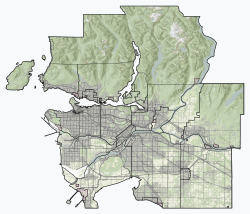History
Early immigration
The first South Asian immigrants from Punjab landed in Vancouver in the 1890s. [3] The first Indian settlement is said to have come by the name of Paldi after a village near Hoshiarpur in Punjab. They settled down in Kitsilano near First Avenue and Burrard Street, where many worked in lumber mills and at construction sites throughout the Lower Mainland.
Indians who later immigrated to Vancouver are believed to have suffered the same treatment given to the Chinese (Chinatown) and Japanese (Japantown). They were subject to the bias and animosities of the predominantly Anglo-Saxon majority and occupied distinct and discrete quarters of the city. Most of the new residents sought established homes and to earn reasonably secure incomes. They settled in the area near 49th Avenue and Main Street and many established restaurants and businesses there and throughout the city to make a living. The settlers brought with them distinctive habits and attitudes that influenced the choice of food, work and recreational activity.
Establishment
Over time, the neighbourhood had become predominantly Indo-Canadian and on May 31, 1970, Sucha Singh and Harbans Kaur Claire opened the first shop on Main St, which would be joined by dozens more, between 48th and 50th avenues. The Claire's owned and ran Shan Sharees and Drapery. [4]
In recognition of the cultural and business importance of the market, the first bilingual street-signs in Punjabi and English were installed in 1993 at the corner of 49th avenue and Main Street. [5]
Present day
Presently, the Punjabi Market is in a period of transformation. Gradually beginning in the 1980s, the suburbanization of the South Asian community in Vancouver caused many to relocate from South Vancouver east towards Surrey and Delta due to high rents and housing prices on relatively small properties. [6] Enticed by cheaper housing for larger properties, new waves of South Asian immigrants in the 1990s and 2000s also preferred to settle in Surrey and Delta. [7] Coupled with high retail rents and the geographical shift in the consumer base, the decline of the Punjabi Market in South Vancouver as a prominent South Asian inner-city district has occurred over the past two decades, with reports in 2013 citing growing retail vacancies. [8] [9] [10] [11] [12] [13] The market has evolved from the traditional food, clothing and jewellery stores to a more diverse offering, which now includes a licensed cannabis shop. [14] Small businesses have been a hallmark of the market throughout the years, but are facing headwinds. Recent development of commercial space has brought chain stores such as a Tim Hortons into the heart of the market. [15]
In 2016, the City of Vancouver first engaged a study and a community planning process to review neighbourhood policies impacting arts, culture, retail and public spaces. [16] In October 2019 six community engagement events were held taking feedback about priorities for residents and business owners. The City of Vancouver staff produced a summary, which included public priorities and 8 recommended actions for Council to consider for the near term. [17] The recommended actions included: Historic Context Statement, Cultural Grants, Vancouver Plan Activities, Near Term Public Realm Improvements, 50th Anniversary Proclamation, Community Art in Public Realm-Call for Artists, Commercial Area Capacity Building Work and Business to Business Support, and Long Term Community Stewardship Partnership.

Surrey is a city in British Columbia, Canada. It is located south of the Fraser River on the Canada–United States border. It is a member municipality of the Metro Vancouver regional district and metropolitan area. Mainly a suburban city, Surrey is the province's second-largest by population after Vancouver and the third-largest by area after Abbotsford and Prince George. Seven neighbourhoods in Surrey are designated town centres: Cloverdale, Fleetwood, Guildford, Newton, South Surrey, and City Centre encompassed by Whalley.

Vaisakhi or Baisakhi, also pronounced as Basoa, marks the first day of the month of Vaisakh and is traditionally celebrated annually on 13 April and sometimes 14 April. It is seen as a spring harvest celebration primarily in Punjab and Northern India. Further, other Indian cultures and diaspora celebrate this festival too. Whilst it is culturally significant as a festival of harvest, in many parts of India, Vaisakhi is also the date for the Indian Solar New Year.
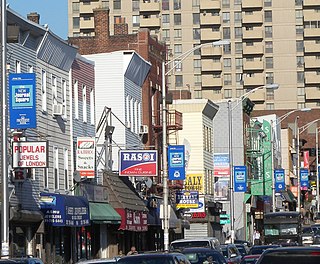
Little India is an Indian or South Asian sociocultural environment outside India or the Indian subcontinent. It especially refers to an area with Indian residences and a diverse collection of Indian businesses. Frequently, Little Indias have Hindu temples, mosques, and gurdwaras. They may also host celebrations of national and religious festivals and serve as gathering places for South Asians. As such, they are microcosms of India. Little Indias are often tourist attractions and are frequented by fans of Indian cuisine, Indian culture, Indian clothing, Indian music, and Indian cinema.

South Asian Canadians are Canadians who were either born in or can trace their ancestry to the Indian subcontinent, which includes the nations of India, Pakistan, Bangladesh, Nepal, Sri Lanka, Bhutan, and the Maldives.

East Vancouver is a region within the city of Vancouver, British Columbia, Canada. Geographically, East Vancouver is bordered to the north by Burrard Inlet, to the south by the Fraser River, and to the east by the city of Burnaby. East Vancouver is divided from Vancouver's "West Side" by Ontario Street.

Killarney is a neighbourhood in East Vancouver, British Columbia with a population of over 28,000 in 2011 and lies in the far southeast corner of the city. It is on the south slope of the ridge that rises above the Fraser River, and contains a collection of single-family residences with a few multi-family homes as well as the townhouses and high-rises of the Fraserlands development along the river.

Oakridge is a neighbourhood in Vancouver, British Columbia, Canada, with a multicultural residential and commercial area. It had a population of 13,030 in 2016, of which approximately 50 percent have Chinese as their mother tongue.
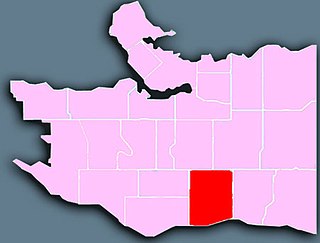
Sunset is the most ethnically diverse neighbourhood in Vancouver, British Columbia. It is located in the south-east quadrant of the city. Surrounding the multicultural Fraser Street district, Sunset is bordered by both the Marpole and Oakridge neighbourhoods to the west, and the Victoria-Fraserview neighbourhood to the east.

Sikhism in Canada has nearly 800,000 adherents who account for 2.1% of Canada's population as of 2021, forming the country's fastest-growing and fourth-largest religious group. The largest Sikh populations in Canada are found in Ontario, followed by British Columbia and Alberta. As of the 2021 Census, more than half of Canada's Sikhs can be found in one of four cities: Brampton (163,260), Surrey (154,415), Calgary (49,465), and Edmonton (41,385).
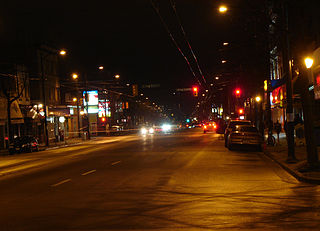
Main Street is a major north–south thoroughfare bisecting Vancouver, British Columbia, Canada. It runs from Waterfront Road by Burrard Inlet in the north, to Kent Avenue alongside the north arm of the Fraser River in the south.
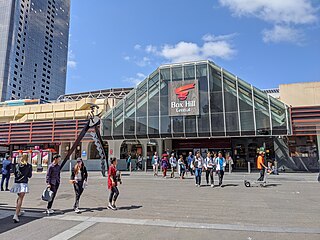
An ethnoburb is a suburban residential and business area with a notable cluster of a particular ethnic minority population. Although the group may not constitute the majority within the region, it is a significant amount of the population. That can greatly influence the social geography within the area because of cultural and religious traditional values exhibited. Ethnoburbs allow for ethnic minority groups to maintain their individual identity, but that may also restrict their ability to fully assimilate into mainstream culture and society.

Indo-Canadians are Canadians who have ancestry from India. The term East Indian is sometimes used to avoid confusion with the Indigenous peoples of Canada. Categorically, Indo-Canadians comprise a subgroup of South Asian Canadians which is a further subgroup of Asian Canadians. According to Statistics Canada, Indians are one of the fastest growing communities in Canada, and one of the largest non-European ethnic groups.
South Asian Canadians in Metro Vancouver are the third-largest pan-ethnic group in the region, comprising 369,295 persons or 14.2 percent of the total population as of 2021. Sizable communities exist within the city of Vancouver along with the adjoining city of Surrey, which houses one of the world's largest South Asian enclaves.
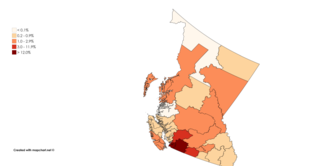
The South Asian community in British Columbia was first established in 1897. The first immigrants originated from Punjab, British India, a northern region and state in modern-day India and Pakistan. Punjabis originally settled in rural British Columbia at the turn of the twentieth century, working in the forestry and agricultural industries.
South Asian Canadians in the Greater Toronto Area form 19% of the region's population, numbering 1.1 million as of 2021. Comprising the largest visible minority group in the region, Toronto is the destination of over half of the immigrants coming from India to Canada, and India is the single largest source of immigrants in the Greater Toronto Area. South Asian Canadians in the region also include significant Pakistanis, Bangladeshis, Sri Lankans, and Nepalis, all representing several different ethnolinguistic backgrounds.

Indians in the New York City metropolitan area constitute one of the largest and fastest-growing ethnicities in the New York City metropolitan area of the United States. The New York City region is home to the largest and most prominent Indian American population among metropolitan areas by a significant margin, enumerating 711,174 uniracial individuals based on the 2013–2017 U.S. Census American Community Survey estimates. The Asian Indian population also represents the second-largest metropolitan Asian national diaspora both outside of Asia and within the New York City metropolitan area, following the also rapidly growing and hemisphere-leading population of the estimated 893,697 uniracial Chinese in the New York City metropolitan area in 2017. The U.S. state of New Jersey, most of whose population is situated within the New York City metropolitan region, has by a significant margin the highest proportional Indian population concentration of any U.S. state, with a Census-estimated 4.6% of New Jersey's population being an individual of Indian origin in 2023.
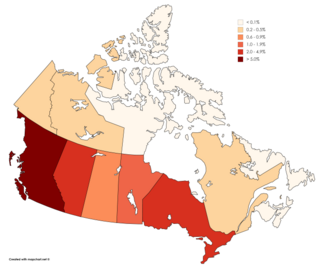
Punjabi Canadians number approximately 950,000 and account for roughly 2.6% of Canada's population, as per the 2021 Canadian census. Their heritage originates wholly or partly from the Punjab region of India and Pakistan.
Oak Tree Road is a predominantly South Asian shopping, business, and dining district centered on a road designated County Route 604 in Middlesex County, in Central New Jersey. The district, which has been called "Little India", is set amidst a suburban residential area that is home to many South Asian families.

Alex Sangha is a Canadian social worker and documentary film producer. He is the founder of Sher Vancouver which is a registered charity for lesbian, gay, bisexual, transgender, queer, and intersex (LGBTQI+) South Asians and their friends. Sangha was the first Sikh to become a Grand Marshal of the Vancouver Pride Parade. Sangha received the Meritorious Service Medal from Governor General Julie Payette in 2018 for his work founding Sher Vancouver. Sangha's first short documentary film, My Name Was January, won 14 awards and garnered 66 official selections at film festivals around the world. Sangha's debut feature documentary, Emergence: Out of the Shadows, was an official selection at Out on Film in Atlanta, Image+Nation in Montreal, and Reelworld in Toronto. The film was the closing night film at both the South Asian Film Festival of Montreal and the Vancouver International South Asian Film Festival where it picked up Best Documentary. Emergence: Out of the Shadows also had a double festival premiere at the KASHISH Mumbai International Queer Film Festival and the Mumbai International Film Festival during the same week, where it was in competition at both film festivals for Best Documentary. The film also had an in-person and online screening at the 46th annual Frameline: San Francisco International LGBTQ+ Film Festival which is "the longest-running, largest and most widely recognized LGBTQ+ film exhibition event in the world."
